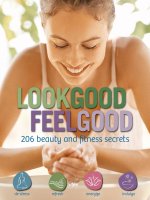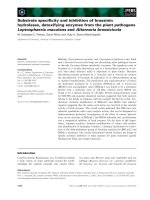Look Good, Feel Good: 206 Beauty and Fitness Secrets Paperback
Bạn đang xem bản rút gọn của tài liệu. Xem và tải ngay bản đầy đủ của tài liệu tại đây (19.82 MB, 21 trang )
206 beauty and fitness secrets
LOOKGOOD
FEELGOOD
refresh
indulge
energize
de-stress
Introduction
Health, well-being, beauty, calm . . . these are all things we aspire to have in our lives.
Who wouldn't want to live a stress-free, centered life—and, just coincidentally, have
gorgeous hair, glowing skin, and a shapely figure? We know these things are important
and rewarding but so often in the rush of everyday life, we put off caring for ourselves.
Who has time for meditation, exercise, or luxury? The answer is that everyone can have
the time. That’s where this book comes in.
In the pages that follow, you’ll find hundreds of simple, imaginative, and practical ideas
for enhancing your health, outlook, and appearance. Drawn from a variety of fields,
including everything from aromatherapy and yoga, to massage and nutrition, these
ideas are organized thematically to help you attain specific benefits, such as renewed
energy, a stronger body, blissful relaxation, or a little well-earned pampering. The approach
is holistic—the needs of the body, mind, and spirit are all addressed—and the activities, all
contributed by experts in their fields, combine the best of time-honored, traditional
disciplines with the latest scientific findings.
The activities described here will give you a taste of many treatments and traditions
including skin care, hair care, spa treatments, aromatherapy, massage, yoga, meditation,
breathing techniques, Pilates, tai chi, general fitness, and nutrition. The exercises are
designed for beginners, but the descriptions aren’t meant to be treatises on the subject.
Rather, the intention is that these peeks into various disciplines and ideas will help you
identify some new fields that interest you and lead you to investigate them further.
Read Look Good, Feel Good from beginning to end, or just start by looking for the
chapters that most spark your interest—whether it’s learning new ways to unwind, new
ways to prevent illness, or new reasons to treat yourself with a little more care. Read on
for brief synopses of the treatments and traditions covered.
skin care, hair care, and beauty treatments
The world of beauty has long been the domain of women and has long been filled with all
sorts of wonderful (and sometimes not-so-wonderful) tips that are passed from mother to
daughter, friend to friend, and beautician to client. Throughout the 20th century, and even
today, some beauty products have become increasingly laden with chemicals and oriented
toward covering, rather than enhancing, our features. But these days, numerous simple,
natural products are also available to make you look and feel your best. The greatest beauty
secret of all? Many of the treatments are doable in just a few minutes in the privacy of your
home, as you’ll see in the suggestions we offer in the following pages.
aromatherapy
The use of essential oils (oils distilled from aromatic plants) to promote physical, emotional,
and spiritual health dates back at least 6,000 years. Today, essential oils are used in a number
of ways—in massage oils and body lotions, dispersed in the bath, and diffused in the air.
Available in health and beauty stores, as well as on the Internet, essential oils are used to treat
a range of maladies and conditions, including stress, depression, headaches, anxiety, menstrual
discomfort, and skin problems. While some say that anything that smells good will make you
feel good, recent scientific research has shown that aromatherapy truly has health benefits.
massage
In today’s fast-paced, individualistic world, one crucial lesson is often forgotten:
Humans need touch, and touch is a powerful healer. Indeed, for thousands of years, many
cultures have practiced some form of massage with the aim of easing physical, mental, and
spiritual ailments. That’s not simply the stuff of folklore—research shows us again and again
that touch can help reduce stress hormones, alleviate depression, boost the immune system,
and diminish pain. And effective massages don’t have to come only from certified massage
therapists. Simple massages—like those we’ve chosen here—can also be exchanged at home
between lovers, friends, and family members, as well as administered to oneself.
tai chi
An ancient martial art that originated in China, tai chi (pronounced tie-CHEE)
is also known as Chinese shadow boxing. Now it is used as both a fighting and
a healing technique, as well as a form of moving meditation. In Chinese, tai
means “great” and chi means “energy,” and the practice is all about experiencing,
strengthening, and enhancing the flow of life energy in the body. Tai chi consists
of a series of slow, graceful, and, ultimately, very powerful movements that involve the
whole body and require intense mental focus. A sequence of tai chi movements is
called a form, and if you practice these forms on a regular basis, they’ll help you stay
physically healthy, mentally sharp, and spiritually grounded. Some forms are difficult;
the exercises we’ve included are simple enough for anyone to try at home.
general fitness
A strong body gives you the foundation for moving with confidence through the
world. People who are fit tend to feel more capable and energetic; they also reduce
their risks of getting some diseases, of becoming obese, and of falling and suffering
physical injuries. We’ve chosen a variety of general fitness exercises to help you
strengthen your body and enliven your workout routine.
Some of the activities described in this book could be dangerous if performed incorrectly.
When performing the physical exercises, for example, please take the time to read the
text—don’t just look at the pictures—and never push so hard that your body hurts. When
you’re practicing massage, it’s important to remember not to massage directly on top of the
spine or over varicose veins, open wounds, areas of intense pain, skin rashes, infections, or
bruises. If you’re pregnant, avoid exercises that impact the abdomen and those requiring
deep work on your hands or feet. Pregnant women also shouldn’t experiment with
aromatherapy, and anyone using essential oils should read the instructions and warnings on
the product labels before even opening the bottles. For instance, essential oils are almost
never to be applied undiluted directly on the skin, and people with high blood pressure
should avoid using stimulating oils. Be sure to perform patch tests of all beauty products to
determine whether you might have an allergic reaction to the ingredients. If you're
uncertain about the suitability of an exercise program or health-related practice, consult
with your doctor or other health-care professional to determine whether it's right for you.
h
A
hectic daily routine—never mind those
spur-of-the-moment crises—can wreak
havoc on your mind and body. Just as muscles
need time to recover between strength-training
sessions, your entire being needs time to relax
amid the whirlwind of activities.
Taking the time to daydream, stretch, and observe
the world around you can yield some amazing
dividends. Your mind clears, your body recovers,
and your spirit has the freedom to soar.
Remember that letting things go can be as
important as getting them done. In fact, letting
go is sometimes the best way to ensure that you
are able to do your best. After all, a relaxed body
moves more freely. A calm mind hears its muse
more easily. And a tranquil heart can better be
open to feeling love and happiness. •
13
12
Don’t Fight It
Part of the reason your
neck and shoulders ache
when you’re under stress is
the fight-or-flight mode
that the body automatically
assumes when exposed to
a threat, whether a hungry
tiger or a peevish boss!
When this self-preservation
mechanism kicks in, the
shoulders hunch upward
and the neck instinctively
cocks the head forward.
Consciously take a moment
to release that defensive
posture when you’re in the
middle of a rough day.
Even if no one is around to lend a helping hand, you can find welcome
neck relief with this series of do-it-yourself rubs and stretches.
1 Turn your head to the side to find your sternocleidomastoid muscle
(for obvious reasons, usually just referred to as the SCM). The SCM
starts on the breastbone and collarbone, crosses the neck at an angle,
and attaches to the base of the skull behind the ear. Press in with your
thumb and grasp the bottom of the SCM from behind. Hold using
firm pressure while you slowly turn your head from side to side three
times. Then repeat in a new spot one inch higher. Work both sides of
your neck from bottom to top.
2 Now turn your attention to the back of your head. Press in firmly
with your thumbs at the base of your skull and move them in tight,
firm circles. Begin on either side of the spine and work outward along
the base of your skull toward the ears. If you encounter sore points,
stop and press firmly on each as you take three deep breaths.
3 Grasp something stable, such as a tabletop, with your right hand and
turn your head as far to the left as is comfortable, sitting or standing up
tall. Stretch your neck muscles by gently guiding your chin farther to
the left with your left hand. Hold the stretch for three deep breaths.
Gently release and repeat on the other side.
4 Place your left hand on your left shoulder. With your right hand,
gently guide your head down toward your right shoulder. Breathe in
and out slowly, feeling your neck muscles gradually lengthen over the
span of three breaths. Bring your head slowly back to center. Repeat
on the other side. You can do this stretch a number of times, holding
your head at different angles to isolate various muscles.
Knead the Knots
Out of Your Neck
28
29
30
Pay attention to the source
when you’re choosing your
water. To earn the official
designation “mineral water,”
the water must originate from
an underground source, be
collected directly from where
it emerged from the ground,
contain a certain amount of
naturally occurring minerals
and other trace elements, and
be free of pollution.
Choose Fresh
Mineral Water
Some spa-goers believe that hydrotherapy is the closest thing they’ll
ever find to the fountain of youth, crediting bathing in mineral waters
with the power to keep them looking and feeling young. Enjoy some
of the benefits of mineral water at home by preparing a restorative bath
that will not only make you feel wonderfully relaxed but will also go a
long way toward enhancing your sense of general well-being.
Fill your bathtub with very warm water, enough to completely cover
your shoulders. Add a handful of scented mineral bath salts to the water
and mix them with your hand until they completely dissolve. Ease into
the tub, lie back (use a bath pillow or rolled-up towel to cradle your
neck, if you like), and close your eyes. Rest in the softening bath for
at least 20 minutes, breathing slowly and deeply.
Soak in the Healing
Power of Hydrotherapy
Hydrate Well While Bathing
Before getting into a mineral bath, pour yourself a tall glass of chilled
mineral water and place it within easy reach of the tub. To make it even
more refreshing, add slices of lime, lemon, or cucumber. When you’re
immersed in very warm water, you’ll perspire, so it’s important to keep
your body well hydrated. Sip the cool mineral water as you soak.
After you’ve finished bathing and have dried yourself off, be sure to
refill your water glass and keep it nearby; you’ll want to continue
drinking plenty of water after the treatment to stay hydrated.
63
64
Detoxifying Steam Blend
Large bowl filled with boiling water
3 drops grapefruit essential oil
2 drops rosemar y essential oil
4 sprigs fresh rosemary (optional)
4 grapefruit slices (optional)
Steaming opens up the skin’s pores, helping to dislodge any grime
and makeup residue, and imparts vital moisture to deeper skin layers.
It softens dead skin cells, making it easier to exfoliate them with a
gentle facial scrub. A steaming session also increases circulation to
your face and relaxes facial muscles. To intensify the detoxifying
effects and feel extra refreshed, add aromatic oils to the treatment.
1 Fill a bowl with boiling water. Add grapefruit and rosemary
essential oils (see recipe at right), as well as sprigs of fresh rosemary
and slices of grapefruit, if desired.
2 Lean over the bowl, taking care to keep your face about 12 inches
away. Let comfort be your guide—steaming should be a pleasant
experience, not an endurance test.
3 Drape a bath towel over your head and the bowl to trap the
vapors. (If the vapors sting your eyes, keep them closed.)
4 Steam your face for five to ten minutes.
Steamed skin is fragile. Blot your face gently with a soft towel and,
while your face is still slightly damp, apply a moisturizer. Top off your
steam by drinking plenty of water.
Add Essential Oils
to a Steam Facial
Detoxify with Essential Oils
Aromatherapists often recommend grapefruit essential oil to relieve
acne and tone the skin. You can use it in a steam blend or add it to a
base lotion to create a healing moisturizer. Rosemary oil also serves as
an astringent and an antibacterial agent that helps prevent pimples.
Other detoxifying essential oils include juniper, geranium, Atlas cedar,
sweet orange, and bay laurel. Experiment with individual oils and
blends to find which are most pleasing and effective to you.
h
W
ith all the things we’d like to do—let
alone have to do—it’s no wonder that
few of us are able to breeze through the day with
energy to spare. In fact, chronic fatigue is one of
the most common complaints doctors hear.
Often the energy-sapping culprits are lifestyle
factors such as too little sleep, overscheduling,
and, above all, stress.
While you can’t add more hours to the day, you
can rethink your work, family, and social
commitments, and learn to say no to the ones
that are less pleasurable or pressing. If a lack of
sleep is your downfall, the solution is obvious—
get more of it—but, in the real world, that can be
hard to do. If you’re feeling stressed—the number
one cause of chronic fatigue—the exercises,
treatments, and activities in this chapter are
guaranteed to help you handle everyday stress
better and put a little more zip in your step. •
115
114
1
2
The challenging Dolphin pose, reminiscent of the graceful arc of a
dolphin’s body, builds upper-body strength and provides a pleasant
stretch for the back muscles that run along your spine. It also promotes
neck strength, which is vital for preparing for headstands and other
demanding poses.
1 To get into position, kneel down and grasp each of your upper arms
with the opposite hand. Then, still grasping your upper arms, place
your elbows on the floor. Keeping your elbows where they are, release
your hands and interlace your fingers; lower your forearms to the floor.
Make sure that your elbows are slightly closer together than your
shoulders are. Next, simultaneously press down with your arms, as if
you’re trying to push the floor away from your chest, and lift your hips
as pictured. Lengthen your spine and allow your head to hang down.
Keeping your back straight, inhale and extend your head past your
hands, reaching forward with your chin.
2 Exhale and press your chest toward your feet so that your head
comes inside your arms. Let your neck relax. Move back and forth
between the positions as many times as your comfort level allows.
Get Strong Shoulders
with Dolphin Pose
To get the most out of
static stretching, give your
muscles the time they need
to let go:
Warm up with at least
five to ten minutes of
aerobic activity, which
can be as simple as brisk
walking.
Gently stretch to the
point of tension, never
pain, and then hold for
30 seconds to two
minutes. Look at your
watch—this often will
feel like a long time!
Breathe deeply and try
to focus on releasing
muscle tension during
exhales. Make your
exhales longer than
your inhales.
Do not bounce. Strive for
a gentle, sustained
stretch, breathing through
areas of resistence until
they naturally release.
Never force a stretch.
Time Your
Stretches
Find Your Inner
Flexibility
It’s tempting to think that you’re fit if you’re strong and in good
aerobic shape. But be sure to also work on flexibility, the third leg of
any fitness program. Muscles that are short or stiff are more prone to
injury, as are the joints near those muscles. On the other hand,
lengthened muscles and joints with a good range of motion (both of
which come from stretching) withstand trauma more easily and
perform better in both competitive sports and daily activities.
150
14 9
151
Just like stretching your legs, these easy self-massage techniques will
help warm you up, pump you up, and even undo damage.
1 Relax tension in your hamstrings with a little jiggle before exercise.
Sit on the ground or a bench, bend one knee up slightly, and grasp the
muscles on the underside of that thigh with one hand. Begin waggling
them loosely from side to side. Move up and down the length of your
thigh, jostling your leg muscles as you go. Do six times on each leg.
2 Compress your quadriceps. Sit and bend one knee up slightly, as
before. With the heels of both palms, press down into your thigh
muscles, squeezing toward the bone in a pumping action. Release the
pressure and move to a new spot, repeating from knee to hip. For extra
power, rock your body forward as you press in, and lean back on your
release. Work both of your legs from the knee to the hip six times.
3 Roll the calf muscles. With palms pressed into the fleshy part of
your calf, rapidly push up with one hand while pulling down with the
other, creating a rolling motion, for 30 seconds. Work both legs.
4 Starting near one ankle, press with the heel of your palm straight in
toward the bone, and release. Pump the calf muscles in a rhythmic
manner, moving toward your knee. Repeat this set of compressions
three times, then work the other leg.
Love Your Legs with
a Sports Massage
Invigorating sports
massages can be beneficial
either before or after a
workout. They are usually
short in duration; just a few
minutes is restorative
without being overly
relaxing for the recipient.
The brief rubdowns also
give the hardworking
massager a break, as they
require quite a bit of
energy to give.
Keep It Short
and Sweet
Soothe Minor Sports Injuries
with PRICE
Most sports injuries are sprains (damage to ligaments, which link
bones together), strains (damage to tendons, which bind muscles to
bones), and contusions (bruises). A good strategy for treating minor
injuries is PRICE: Protect (use bandages, elastic wraps, or splints, if
needed), Rest (don’t exercise the injured body part), Ice (10 to 15
minutes every hour for the first four hours, then four times a day for
two to three days), Compress (with an elastic cloth bandage), and
Elevate (use gravity to drain fluid away from injured tissue). After two
to three days, switch to heat to relieve discomfort.
16 0
161
2
1
Keep your yoga routine fresh and your body and mind stimulated by
expanding your repertoire. Various Pigeon poses let you work with
challenging but gratifying hip releases.
1 To perform Pigeon pose, get on all fours. Bring your left knee
forward between your hands, with your foot positioned to the right so
your leg forms an inverted V shape. Extend your right leg straight back
and allow your hips to sink, keeping them level to the floor. Be careful
not to roll onto your left thigh or strain your knees. Elongate your
spine, lift your chest, and keep your palms on the floor and your
shoulders loose and low. Hold for four to six breaths (but release at the
first sign of any strain). To release, push down with your palms, lift your
hips, and slide your left leg back. Repeat on the other side.
2 In Low Pigeon pose, your weight falls more on your arms and a bit
less on your hips. From Pigeon pose, place your forearms on the floor
shoulder-width apart. Lower your weight onto your forearms, relaxing
over your bent leg. If this is comfortable, release more weight onto
your bent leg by extending your arms completely and letting your head
rest on (or hang toward) the floor. Note any resistance in your body,
and encourage these muscles to surrender to the pose. Hold for four to
six breaths. Release and repeat on the other side.
Try Variations
on Pigeon Pose
If you find it difficult to
keep your hips level in
either Pigeon pose, try
placing a firm pillow or a
folded blanket under the
hip of your bent-leg side.
The farther your hips are
from the floor, of course,
the thicker the pillow or
blanket needs to be. With
practice, you gradually
will need less support.
Support
Your Hips
Protect Your Knees
in Pigeon Pose
The variations of Pigeon pose provide challenging opportunities to
work on releasing your hips. Your hips work in harmony with your
knees, which may try to compensate for restrictions in the range of
motion of your hip joints. When working to open your hip joints, take
care not to strain your knees. Use a blanket to support your hips (see
photo at right) if needed, and release the pose at any sign of strain.
Remember, the yoga practice doesn’t end when you leave your mat;
observe how your body is affected by your practice immediately
afterward and, as you practice regularly, over time.
162
h
P
art of being a grown-up is knowing what
you enjoy—the food you savor, the
company you keep, and the activities you love.
Sometimes, you might feel a little guilty about
indulging in life’s pleasures. But there’s a time
and a place for everything, and when it’s your
turn to revel in a little well-deserved pampering,
we’ve got some ideas for you.
The activities in this chapter delight the senses—
from perfuming your bedroom to exchanging
massages by a flickering fire. These treatments
go beyond simple maintenance to sensual joys.
You’ll find suggestions for revitalizing a tired
body, reconnecting with your surroundings, and
surrendering to a grown-up time-out. Whatever
activity you choose, an indulgence should please
the senses, calm the mind, and lift the spirit. And
above all, it should make you happy. •
188
Right Foot Reflexology Map
Here are some of the key
reflexology points on the sole of
your right foot:
1 Sinus, head, and brain
2 Eyes and ears
3 Arms
4 Shoulders
5 Lungs and breasts
6 Liver
7 Kidneys
8 Sciatic nerve
Reflexologists believe zones in the feet exert beneficial influences on
other body parts when pressed. A foot massage also ranks among life’s
simple pleasures. Recruit a friend to treat you to these soothing steps:
1 Get into a comfortable position for massaging your friend’s foot. To
activate the reflexology zones, begin by using your thumb to make
deep, overlapping circles over the entire surface of her heel and arch.
Then place your thumb just above her arch at the base of the ball of
the foot and press into one of the grooves between the bones that lead
up to the toes. Circle with your thumb up each groove, moving from
the top of the arch toward each toe.
2 Grip her foot with both hands, with thumbs holding the bottom of
the foot at mid-heel level. With your thumbs braced side by side for
firm pressure, glide up her sole to the grooves in the ball of the foot
and then up to the space between the big and second toes. Ease your
grip and slide lightly back to her heel. Repeat two more times.
3 Give each toe an individual massage by pressing your thumb and
index finger together and circling from base to tip. Then wiggle each
toe backward, forward, and around in circles, starting with small circles
and spiraling into bigger ones, being careful not to bend the toes too
far. For a soothing finish, do a foot sweep: Contour and press your
hands together on the top and bottom of your friend’s foot. Gently pull
your hands toward you and off her toes three times. Then repeat all
these massage steps on the other foot.
Get in the Zone with
Foot Reflexology
1
2
3
4
5
6
7
8
1
1
1
1
195
Induce Peace Through Scent
Make a comforting potpourri
from a mixture of dried orange
rinds and lavender, rose, and
jasmine petals—perfect on
your nightstand or desk. A few
drops of the corresponding
essential oils will help make
the fragrance more pronounced
and longer-lasting.
A perennial aromatherapy favorite, lovely bags or bowls of delicious
scents can spice up a room, sweeten a friendship, or even evoke
memories and moods. Potpourri is a combination of aromatic and
decorative ingredients, such as dried flower petals, leaves, fruits, spices,
and wood shavings, sprinkled with essential oils. Better-quality
potpourri also contains fixatives, such as orrisroot, that absorb and
slowly release the essential oils, helping the fragrance last longer.
You can purchase ready-made potpourri at gift and craft stores, but
you might find it more rewarding to create your own special blend.
First, find a potpourri recipe that sounds appealing; look in books,
browse online, or try the recipe at left. Craft shops, herb catalogs, and
natural-food stores will have the ingredients you need (as might your
own backyard), but you’ll also need a few tools, such as clean glass jars,
a kitchen scale (for measuring ingredients), and glass eyedroppers (one
for each oil you use). Be forewarned: Making potpourri doesn’t take
much time, but the mix has to settle for about three weeks before it’s
ready to use, so plan ahead if you’re making gifts.
Once your mixture is ready, you can put it in pretty bowls and place
them strategically throughout your home (avoid using very strongly
scented potpourri near where you’re eating, because it can interfere
with the taste of your food). You also can make sachets by placing
potpourri in small bags of porous cloth, such as linen, cotton, or silk,
tied with ribbons; these impart a delicate scent to your clothes when
placed in closets or dresser drawers.
To really unleash the aroma of your mixture, sprinkle the potpourri
in a pot of water and simmer it on the stove. Besides these purely
atmospheric uses, potpourri can serve practical purposes: Ingredients
such as rosemary, citronella, sage, cedar, and lavender help repel moths,
for example, while a mixture of chamomile, bergamot, lavender, and
clary sage placed at your bedside helps promote a good night’s sleep.
Spice Up the Atmosphere
with Potpourri
The soft, dancing light provided by candles can create an enchanting and
alluring environment. Placing a few or even a whole collection of candles
throughout a room can transform it into a lovely, magical space in just a
matter of minutes: Your kitchen suddenly feels like an atmospheric café,
your bathroom a luxurious spa, and, perhaps most dramatic, your bedroom
a mysterious and seductive hideaway.
If you’d like to enjoy the benefits of aromatherapy, place a few drops of
essential oil on an unscented candle, near its wick. As the wax melts, the
aroma will be released. Remember that essential oils are flammable; don’t
use too much or put them directly on a burning wick. In the bedroom,
you might try using the oil from ylang-ylang flowers; it’s reputed both to
be an aphrodisiac and to alleviate performance anxieties, as does vetiver,
which is known as “the oil of tranquility.” Candles scented with jasmine,
patchouli, neroli, sandalwood, frankincense, geranium, or rose are also
thought to put one in the mood for love.
Set the Mood with
Flickering Candles
Acknowledgements
All photographs courtesy of John Robbins, with the following exceptions:
Sheri Giblin 12, 26, 48, 80, 91, 108, 119, 121, 142, 149, 167, 203
Shutterstock Table of Contents, Introduction, Taking Care, 4, 14, 18, 23,
31 (sidebar), 33, 42, 45 (sidebar), 47, 65, 68 (sidebar), 73 (sidebar), 82, 85,
86, 89 (sidebar), 90, 92, 97, 98 (sidebar), 101, 102,103, 104 (sidebar), 105
(sidebar), 106, 110, 112, 115, 129, 131, 135 (sidebar), 136, 141, 143, 151,
163, 164, 172 (sidebar), 176 (sidebar), 178, 185 (sidebar), 189, 192, 198,
201, 202, 203 (sidebar)
iStock 105
415 Jackson Street
San Francisco, CA 94111
www.weldonowen.com
President, CEO Terry Newell
VP, Sales Amy Kaneko
VP, Publisher Roger Shaw
Executive Editor Mariah Bear
Project Editor Elizabeth Dougherty
Assistant Editor Bridget Fitzgerald
Editorial Assistant Ian Cannon
Creative Director Kelly Booth
Senior Designer Meghan Hildebrand
Assistant Designer Sarah Edelstein
Production Director Chris Hemesath
Production Manager Michelle Duggan
© 2013 Weldon Owen Inc.
All rights reserved, including the right
of reproduction in whole or in part in
any form
Weldon Owen is a division of
Library of Congress Control Number
on file with the publisher
ISBN 978-1-61628-452-7
10 9 8 7 6 5 4 3 2 1
2013 2014 2015 2016
Printed in China by 1010 Printing
Weldon Owen would like to thank Barbara
Genetin for designing the chapter openers
and cover, Katharine Moore for
copyediting, Marisa Solis for proofreading,
and Andrew Joron for the index.
A version of this book was published in
2003 under the name The Body Care
Manual. That book could not have been
created without the invaluable
contributions of Creative Director
Emma Boys and Publications Manager
Justine Roddick.









